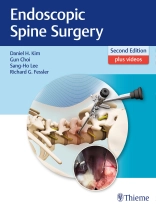Endoscopic technology has advanced to the point where practitioners can now access, visualize, and treat spine pathologies previously only accessible through open surgical approaches. Endoscopic Spine Surgery 2nd Edition provides a comprehensive background on endoscopic spine surgery and covers an unparalleled number of minimally invasive spine procedures that have revolutionized the spine treatment paradigm. Readers will greatly benefit from many years of expertise and wisdom shared by master spine surgeons Daniel Kim, Gun Choi, Sang-Ho Lee, and Richard Fessler, and their expert contributors.
Due to the narrow endoscopic view, subtle microanatomical differences in the lumbar, thoracic, and cervical regions are not always easy to visually discern. To address this challenge, the book contains detailed procedural descriptions and images mirroring endoscopic views spine surgeons encounter in the OR. Organized anatomically, 53 chapters guide readers systematically through lumbar, thoracic, cervical, and craniocervical junction procedures for pathologies ranging from low back pain and deformities to tumors, lesions, infections, and trauma.
Key Features
- More than 1000 high quality images including color procedural photographs and medical illustrations provide in-depth visual understanding.
- Spinal pathologies and procedures delineated in 75 videos accessible via the Media Center – from case studies to step-by-step technique tutorials.
- Covers the full spectrum of spine endoscopy including percutaneous approaches, microdiscectomy, laminectomy, discectomy foraminotomy, hemilaminectomy, thoracic decompressions, fusion, fixation, and thoracoscopic procedures.
- The use of state-of-the-art technology such as ultrasonic bone dissectors, endoscopic radiofrequency denervation, the video telescope operating monitor (VITOM), minimally invasive tubular retractors, and 3D stereo-tubular endoscopic systems.
Neurosurgical and orthopaedic residents, spine fellows, and seasoned spine surgeons will all greatly benefit from the significant knowledge and insights revealed in this remarkable multimedia resource. This book may also be of interest to neurosurgical and orthopaedic nurses, physical therapists, chiropractors, and medical device professionals.
Spis treści
1 Applied Anatomy and Percutaneous Approaches to the Lumbar Spine
2 Percutaneous Endoscopic Lumbar Diskectomy: Transforaminal Approach
3 Percutaneous Endoscopic Lumbar Diskectomy: Extraforaminal Approach
4 Percutaneous Endoscopic Lumbar Diskectomy for Migrated Lumbar Disk Herniation
5 Percutaneous Endoscopic Lumbar Diskectomy with Foraminotomy
6 Surgical Technique for Percutaneous Endoscopic Laser Annuloplasty/Nucleoplasty
7 Interlaminar Surgical Approach for Percutaneous Endoscopic Laser Annuloplasty/Nucleoplasty
8 Percutaneous Endoscopic Interlaminar Lumbar Diskectomy: Structural Preservation Technique for L5-S1 Herniated Nucleus Pulposus
9 Percutaneous Endoscopic Decompressive Laminectomy and Foraminotomy
10 Unilateral Biportal Endoscopic Decompression for Lumbar Spinal Stenosis
11 Percutaneous Unilateral Biportal Endoscopic Diskectomy and Decompression for Lumbar Degenerative Disease
12 Transforaminal Epiduroscopic Laser Annuloplasty for Diskogenic Pain
13 Tubular Endoscopic Lumbar Laminoforaminotomy and Diskectomy
14 Tubular Endoscopic Lumbar Laminoforaminotomy and Diskectomy
15 Tubular Lumbar Decompressive Laminectomy and Foraminotomy
16 Tubular Endoscopic Lumbar Hemilaminectomy and Foraminotomy
17 Ultrasonic Bone Dissectors in Minimally Invasive Spine Surgery
18 Minimally Invasive Tubular Decompression for Foraminal Stenosis
19 Destandau’s Technique: Interlaminar Approach (Lumbar Diskectomy with Canal Decompression)
20 Endoscopic Transforaminal Lumbar Interbody Fusion and Instrumentation
21 Endoscopic/Percutaneous Lumbar Pedicle Screw Fixation Technique
22 360° Endoscopically Assisted Minimally Invasive Transforaminal Lumbar Interbody Fusion
23 Percutaneous Translaminar and Ipsilateral Facet Fixation Technique
24 Direct Lateral Endoscopic Lumbar Interbody Fusion and Instrumentation
25 Endoscopic Removal of Intradural Extramedullary Space-Occupying Lesions
26 Laparoscope- and Endoscope-Assisted Oblique Lumbar Interbody Fusion
27 Endoscopic Radiofrequency Denervation for Treatment of Chronic Low Back Pain
28 Video Telescope Operating Monitor for Spine Surgery
29 Applied Anatomy and Percutaneous Approaches to the Thoracic Spine
30 Surgical Techniques in Percutaneous Endoscopic Thoracic Diskectomy
31 Posterolateral Endoscopic Thoracic Diskectomy
32 Tubular Endoscopic Transpedicular Diskectomy
33 Thoracoscopic Diskectomy
34 Tubular Endoscopic Thoracic Decompressive Laminectomy
35 Thoracoscopic Decompression and Fixation for Thoracic and Thoracolumbar Junction Lesions
36 Endoscopic Approaches to Thoracic Tumors, Trauma, and Infection
37 Thoracoscopic Approaches to Deformity Correction [1]
38 Thoracoscopic Approaches to Deformity Correction [2]
39 Applied Anatomy for Percutaneous Approaches to the Cervical Spine
40 An Endonasal Approach to the Craniocervical Junction
41 Endoscopic Transnasal Approaches to the Craniocervical Junction
42 Endoscopic Transoral Approaches to the Craniocervical Junction
43 Foramen Magnum Decompression of Chiari Malformation Using Minimally Invasive Tubular Retractors
44 Percutaneous Endoscopic Cervical Diskectomy
45 Endoscopic Anterior Cervical Diskectomy and Cord Decompression
46 Video-Assisted Anterior Cervical Diskectomy and Instrumentation
47 Cervical Laminoforaminotomy with Working Channel Endoscope
48 Posterior Percutaneous Endoscopic Cervical Foraminotomy and Diskectomy: Case Presentation and Surgical Technique
49 Posterior Tubular Endoscopic Cervical Diskectomy
50 Posterior Tubular Endoscopic Cervical Laminectomy and Foraminotomy
51 Endoscopic Approaches to Cervical Tumors, Trauma, and Infection
52 Three-Dimensional Spine Surgery: Clinical Application of 3D Stereo-Tubular Endoscopic Systems
53 Minimally Invasive Microsurgical Resection of Spinal Intradural Extramedullary Lesions












